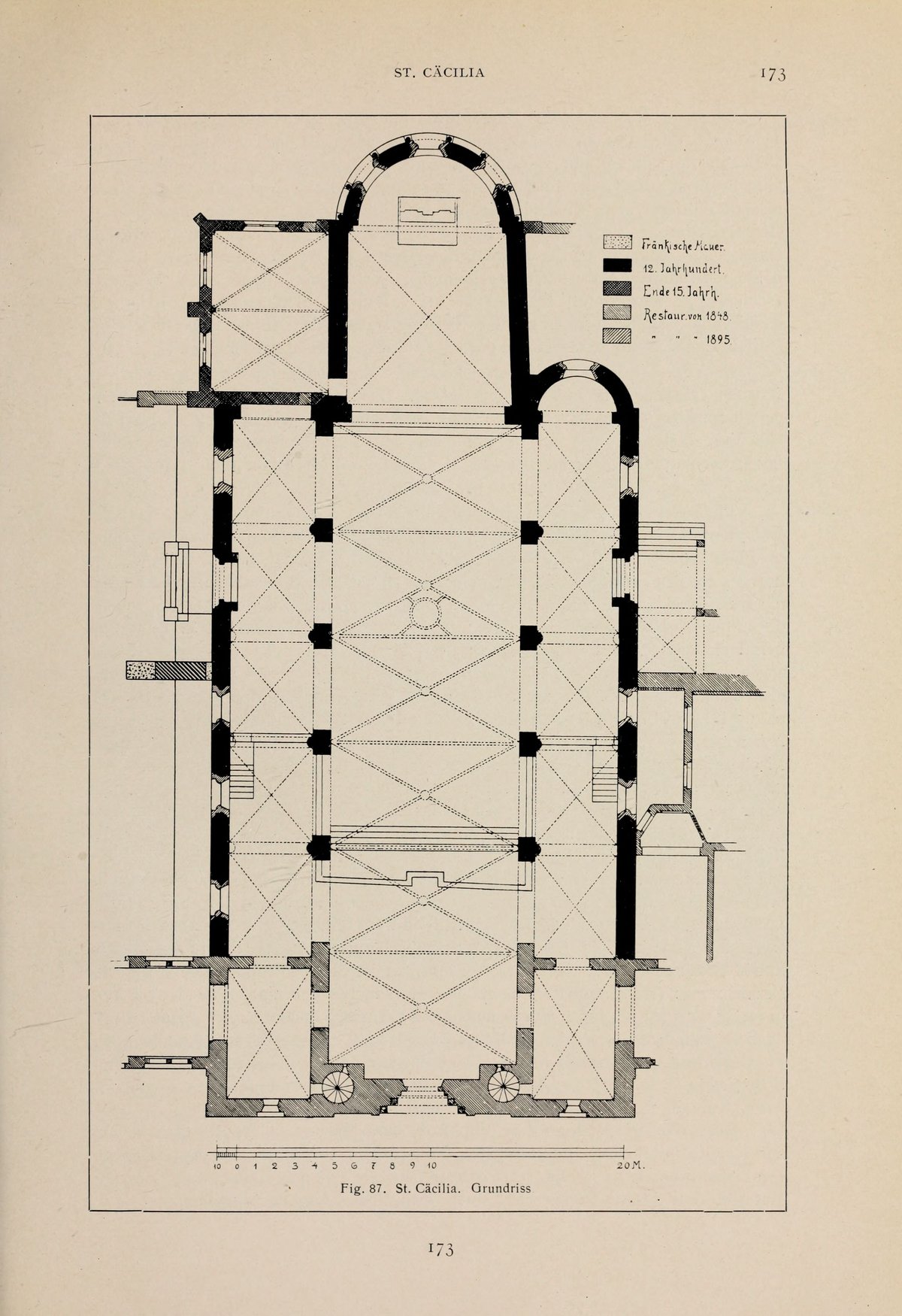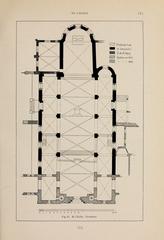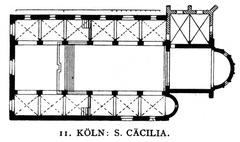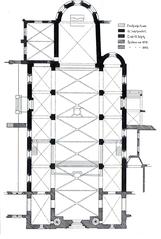
St. Cecilia’s Church Visiting Hours, Tickets, and Cologne Historical Sites Guide
Date: 15/06/2025
Introduction: Discovering St. Cecilia’s Church in Cologne
Situated in the heart of Cologne’s historic Old Town, St. Cecilia’s Church (Cäcilienkirche) stands as a profound symbol of the city’s medieval roots and spiritual legacy. Dating back to the late 9th or early 10th century, the church was originally established as a Benedictine convent, dedicated to St. Cecilia—patron saint of music—a reflection of the era’s spiritual devotion and early commitment to preserving sacred art and liturgical traditions (Cologne Tourism). Over centuries, the church has evolved architecturally, with Romanesque foundations, later Gothic enhancements, and thoughtful 19th-century Neo-Romantic interventions, all while preserving an atmosphere of tranquility distinct among Cologne’s twelve Romanesque churches (Germany Travel Blog).
Today, St. Cecilia’s serves as the home of the Schnütgen Museum, renowned for its exceptional collection of medieval Christian art. Visitors can immerse themselves in a remarkable display of sculptures, frescoes, reliquaries, and liturgical treasures, all housed within the church’s authentic sacred setting (Schnütgen Museum). This guide provides comprehensive information on visiting hours, ticketing, accessibility, and tours, alongside historical and cultural insights, to ensure you make the most of your visit to one of Cologne’s architectural and artistic gems (Medium; Cologne Tourism).
Quick Contents
- Historical Overview: Origins, Architecture, and Cultural Significance
- Visitor Information: Hours, Tickets, Accessibility, and Tours
- Highlights: What to See and Experience
- Nearby Attractions and Suggested Itineraries
- Frequently Asked Questions (FAQ)
- How to Plan Your Visit
Historical Overview
Origins and Foundation
St. Cecilia’s Church is among Cologne’s oldest ecclesiastical sites, with origins rooted in the late 9th or early 10th century. Founded as a Benedictine convent for women, the church’s dedication to St. Cecilia reflects the period’s reverence for saints and the vital role of female monasticism in the city’s religious life (Cologne Tourism). Its earliest documented mention dates to 881 CE, placing its establishment in the Carolingian era and marking it as central to Cologne’s rise as a religious and educational hub.
Architectural Evolution
- Romanesque Beginnings: The church’s structure—built largely in the 12th century—exemplifies Romanesque architecture with massive trachyte walls, rounded arches, and a basilica layout of a central nave flanked by aisles (Germany Travel Blog).
- Later Modifications: Gothic influences emerged in the 13th and 14th centuries, particularly in window design, while the 19th century saw Neo-Romantic updates. Despite these changes, St. Cecilia’s has retained its core Romanesque character.
- Secularization and Restoration: The Napoleonic era led to the convent’s dissolution and the church’s secular use. Later, careful restorations—especially after World War II—preserved its historical integrity, culminating in its transformation into a museum in 1956 (Cologne Tourism).
Cultural and Spiritual Significance
For centuries, the convent was a center of prayer, education, and charity, with the nuns contributing to the preservation of sacred music and manuscript traditions. Today, St. Cecilia’s dual legacy as a former place of worship and current site for the Schnütgen Museum underscores its enduring importance in Cologne’s cultural landscape (Germany Travel Blog).
Visitor Information: Hours, Tickets, Accessibility, and Tours
Opening Hours
- Tuesday to Sunday: 10:00 AM – 5:00 PM
- Closed: Mondays and public holidays
- Confirm current hours on the official Schnütgen Museum website.
Tickets and Admission
- Standard Adult: €8–€10
- Reduced (students, seniors, groups): €5–€6
- Children under 18: Free
- Family Ticket: €16
- Free Admission: Often on the first Thursday of each month after 5:00 PM
- Tickets are available online or at the museum entrance. The KölnCard offers discounts and free public transport.
Accessibility
- Fully accessible with ramps, elevators, and accessible restrooms
- Assistance available upon request; see Cologne barrier-free travel information
Guided Tours and Audio Guides
- Regular guided tours in German and English (approx. 60–90 minutes)
- Audio guides and printed materials available in multiple languages
- Advance booking recommended for tours, especially during peak times
Highlights: What to See and Experience
- Romanesque Architecture: Admire the church’s original nave, choir, and apse, with their robust Romanesque features.
- Medieval Art Collection: View the Schnütgen Museum’s renowned treasures, including goldsmithery, wood and stone sculptures, stained glass, and illuminated manuscripts (The Crazy Tourist).
- Historic Tympanum: Examine the preserved 12th-century tympanum depicting biblical scenes.
- Artistic Details: Discover medieval frescoes (notably in the choir), and Harald Naegeli’s modern “Dance of Death” graffiti on the western façade.
- Photo Opportunities: Capture the unique wooden roof, the tympanum replica at the north entrance, and the serene nave.
Location, Directions, and Amenities
- Address: Cäcilienstraße 29-33, 50676 Cologne, Germany
- Transport:
- By Train: 10-minute walk from Cologne Central Station (Köln Hauptbahnhof)
- By Tram: Lines 1, 7, 9 to Heumarkt; or lines 3, 4, 16 to Neumarkt
- Parking: Several public garages nearby; parking can be limited during peak hours
- Facilities: Restrooms (including accessible), cloakroom, museum shop; cafés and restaurants in Neumarkt and the Belgian Quarter
Suggested Itineraries and Nearby Attractions
St. Cecilia’s Church is centrally located, making it easy to combine with other highlights:
- Cologne Cathedral (Kölner Dom): Germany’s most iconic Gothic cathedral, ~1 km north (Nomadic Matt)
- Museum Ludwig: Modern and contemporary art museum, close to the cathedral
- Roman-Germanic Museum: Archaeological finds from Cologne’s Roman past
- Great St. Martin Church: Another essential Romanesque site
- Cologne Old Town (Altstadt): Historic streets, squares, and traditional Kölsch breweries
- Belgian Quarter: Trendy district with shops and street art
Explore self-guided walking tours via the GPSmyCity app.
Practical Tips for Your Visit
- Best Times: Spring and autumn offer mild weather and fewer crowds. Weekday mornings are especially peaceful (Shirshendu Sengupta).
- Duration: Plan 1.5–2 hours for a thorough visit.
- Dress Code: Modest, respectful attire is recommended.
- Photography: Permitted without flash (confirm current policies at the entrance).
- Family and Group Programs: Interactive workshops and educational tours available for children and school groups.
Alt text: St. Cecilia’s Church Cologne interior showcasing Romanesque wooden roof and rounded apses.
Frequently Asked Questions (FAQ)
Q: What are the visiting hours for St. Cecilia’s Church and the Schnütgen Museum?
A: Tuesday to Sunday, 10:00 AM to 5:00 PM; closed Mondays and some holidays. Check the official website for any changes.
Q: How much do tickets cost?
A: Adult admission is €8–€10, reduced €5–€6, free for children under 18, and €16 for families.
Q: Is the church wheelchair accessible?
A: Yes, with ramps, elevators, and accessible restrooms.
Q: Are guided tours available?
A: Yes, in German and English; audio guides and printed materials are also provided.
Q: Can I take photos inside?
A: Non-flash photography for personal use is generally allowed.
Q: Are there other attractions nearby?
A: Yes, including Cologne Cathedral, Museum Ludwig, Old Town, the Roman-Germanic Museum, and the Belgian Quarter.
Plan Your Visit
St. Cecilia’s Church offers a unique blend of history, architecture, and art—making it a must-see for history buffs, art lovers, and cultural travelers alike. For up-to-date information on exhibitions, tickets, and special events, visit the Schnütgen Museum official website or consult Cologne Tourism.
Enhance your experience with the Audiala app for guided audio tours and interactive maps. Follow us on social media for travel tips, event updates, and stories from Cologne’s rich heritage.
Summary
St. Cecilia’s Church is a testament to Cologne’s enduring cultural and spiritual legacy. From its foundation as a Benedictine convent to its current role as the Schnütgen Museum, it offers visitors an immersive journey through centuries of art, architecture, and devotion. With accessible facilities, guided tours, and a central location, it is an enriching destination for all. For more on Cologne’s Romanesque churches and cultural sites, see the resources below.
Sources and Further Reading
- Cologne Tourism, 2025, Official Cologne Tourism Website
- Germany Travel Blog, 2025, Historical Sites in Cologne
- Schnütgen Museum Official Website, 2025
- Medium, 2024, Romanesque Cologne Article
- Wanderlog, 2024, St. Cecilia’s Church Details
- The Crazy Tourist, 2024, Top Things to Do in Cologne
- Nomadic Matt, Cologne Travel Guide
- Shirshendu Sengupta, Complete Cologne Travel Guide
- GPSmyCity, St. Cecilia’s Church








































































